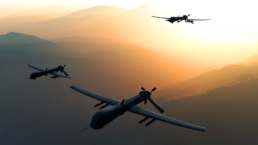The new project, as announced to a confab of defense industry executives yesterday, was no doubt music to their ears.
By Kelley Beaucar Vlahos, Responsible Statecraft
What better place than a National Defense Industrial Association confab to announce a new program in which “multiple thousands” of drones will be unleashed across land, sea, and sky “to counter the PLA’s [People’s Liberation Army’s] mass with mass of our own, but ours will be harder to plan for, harder to hit and harder to beat.”

It rings a bit like science fiction but to a roomful of defense executives, Deputy Secretary of Defense Kathleen Hicks’ words on Monday must have been music to their ears. A lot of dollar signs. Especially when Adm. John Aquilino, head of U.S. Indo-Pacific Command, joined in and told the NDIA “Emerging Technologies for Defense” audience that there could be as many 1,000 drones deployed in 24 hours — “Here’s a metric for me: 1,000 targets for 24 hours.”
At which point Hicks signaled that might be just the baseline. “We’ll also aim to replicate and inculcate how we will achieve that goal, so we can scale whatever’s relevant in the future again and again and again. Easier said than done? You bet. But we’re going to do it,” she said.
Welcome to the second era of the drone war, the first being during the U.S. Global War on Terror, where drones like the MQ Reaper were primarily used for surveillance and manhunting. It was billed as an “evolution” in targeted conflict in which the government promised “cleaner” war with fewer civilian deaths and American boots on the ground. Today’s era is about “meshing” both surveillance and lethal action with a pronouncement of drones, all shapes and sizes, and not just the big expensive ones. This is being tested and improved everyday with tens of thousands of drones on both sides in Ukraine and now the Pentagon is promising the next level of that for its coming war with China.
Recent Posts
Why is the Democratic party hiding its 2024 autopsy report?
December 30, 2025
Take Action Now If the DNC isn’t open and transparent about why they lost, then how can we be sure they will learn their lesson this time?By…
Anti-ICE Resistance Sprang Up Across Red States In 2025
December 29, 2025
Take Action Now In Texas, North Carolina, Alabama, Tennessee, Florida, and beyond, grassroots resistance to ICE is growing.By Sonali Kolhatkar,…
Trump Suggests US Bombed ‘Big Facility’ in Venezuela. No One Seems to Know What He’s Talking About
December 29, 2025
Take Action Now Administration officials have yet to provide any details about the supposed strike, which would mark a massive escalation in the…
Nigerian Village Bombed by Trump Has ‘No Known History’ of Anti-Christian Terrorism, Locals Say
December 28, 2025
Take Action Now “Portraying Nigeria’s security challenges as a targeted campaign against a single religious group is a gross misrepresentation of…




